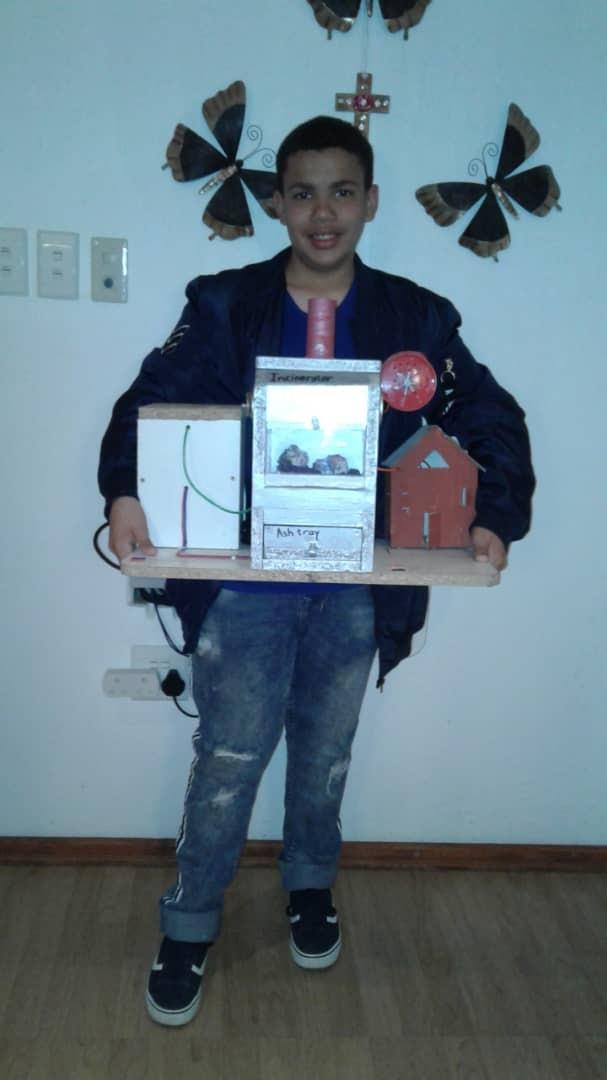From waste to energy
Natango Amadhila, Westside High School
There is a growing tendency for people to become more conscious of environmental conservation and to contribute by reducing, re-using and recycling their household waste.
One such “conservationist” is a Grade 7 learner at Westside High School, Franklin Coetzee.
Franklin recently took part in a recycling competition titled ‘My Trash, My Treasure’, organised by the municipality of Swakopmund.
He was awarded second prize for his interesting project, a mini-incinerator. This incinerator was built from easily accessible and recyclable household materials such as plastic lids, old spray tins, milk cartons and even metal screws.
With the help of his father, Paul Coetzee, Franklin managed to assemble his prize-winning project. This mini-incinerator burns organic waste (plant materials and certain animal products) and can even generate a small amount of electricity.
Larger versions of this kind of incinerator are called waste-to-energy plants. These power plants are important because they reduce the amount of waste ending up in landfills and can generate useful electrical energy. They can generate enough electricity to supply to households and small communities.
Although there are some concerns about waste-to-energy plants creating air pollution, they are relatively safe. These plants have a built-in anti-pollution device that causes the complex chemicals to be broken down into simpler and less harmful compounds.
The ash from the incinerator sometimes contains high concentrations of metals and other substances. The metal is removed and re-used and the remaining components can be used in building roads or making concrete stronger.
Considering Namibia has few power plants, here’s another reason why waste-to-energy plants might be good for us. In about 45 kg of typical trash, at least 36 kg can be burned as fuel to generate electricity at a power plant. Around 1000 kg of rubbish can generate 525 kWh of electricity daily, which is enough for 17 households. So not only would having waste-to-energy plants decrease the amount of waste in landfills, but they could also provide electricity for our communities.
One such “conservationist” is a Grade 7 learner at Westside High School, Franklin Coetzee.
Franklin recently took part in a recycling competition titled ‘My Trash, My Treasure’, organised by the municipality of Swakopmund.
He was awarded second prize for his interesting project, a mini-incinerator. This incinerator was built from easily accessible and recyclable household materials such as plastic lids, old spray tins, milk cartons and even metal screws.
With the help of his father, Paul Coetzee, Franklin managed to assemble his prize-winning project. This mini-incinerator burns organic waste (plant materials and certain animal products) and can even generate a small amount of electricity.
Larger versions of this kind of incinerator are called waste-to-energy plants. These power plants are important because they reduce the amount of waste ending up in landfills and can generate useful electrical energy. They can generate enough electricity to supply to households and small communities.
Although there are some concerns about waste-to-energy plants creating air pollution, they are relatively safe. These plants have a built-in anti-pollution device that causes the complex chemicals to be broken down into simpler and less harmful compounds.
The ash from the incinerator sometimes contains high concentrations of metals and other substances. The metal is removed and re-used and the remaining components can be used in building roads or making concrete stronger.
Considering Namibia has few power plants, here’s another reason why waste-to-energy plants might be good for us. In about 45 kg of typical trash, at least 36 kg can be burned as fuel to generate electricity at a power plant. Around 1000 kg of rubbish can generate 525 kWh of electricity daily, which is enough for 17 households. So not only would having waste-to-energy plants decrease the amount of waste in landfills, but they could also provide electricity for our communities.





Kommentaar
Republikein
Geen kommentaar is op hierdie artikel gelaat nie